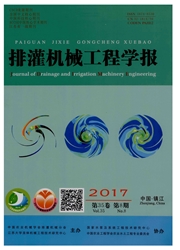

 中文摘要:
中文摘要:
针对田间资料较难明确其改造方案是否合理的问题,文中利用Win SRFR模型对试验结果进行预测,并与实测结果进行对比,明确Win SRFR模型在研究区域的适用性;进而采用单一变量法原则,运用Win SRFR模型设定不同畦长、不同畦宽的畦田规格,模拟不同畦田规格对水流推进和消退运动、土壤含水量分布情况以及灌水效率、灌水均匀度的影响.研究结果表明:在研究区域内,畦宽一定,畦长递增时,水流推进过程时间不变,消退过程时间增大,距离畦首相同位置处土壤水分累积入渗量增大,影响明显.畦长一定,畦宽递增时,单宽流量变小,水流推进过程时间增长,消退过程时间变短;距离畦首相同位置处水分累积入渗量先有减小趋势,在总畦长约3/4处后有明显增大趋势.当畦长在60~80 m,畦宽为5~7 m时可获得最优的灌水质量指标参数,所确定的灌水流量为40 L/s,畦田最佳单宽流量值为5.7~8.0 L/(m·s).结果可为灌区制定合理的灌溉,提高水资源利用效率提供科学依据.
 英文摘要:
英文摘要:
It was very difficult to know the proper size of the field transformation based on the preliminary data,thus Win SRFR model was adopted to predict the experimental results. By comparing the fitted data and experimental results,Win SRFR model was confirmed to be able to predict the result. Moreover,the influence of different length and width of the ridge-borded plots fields on the water advance and regression movement,soil moisture distribution,as well as the efficiency and uniformity of irrigation were simulated. The results show that in the study area,the border check length increased with the water advance process under a certain border check width,and the water regression process wasdelayed; meanwhile,the soil water cumulative infiltration increased at the same position as the head of the ridge,and the influence was obvious. When the border check length was constant and the border check width increased,the flow rate of single width became smaller,the water advance process was promoted and the time of the water regression process became shorter. The soil water cumulative infiltration at the same position as the head of the ridge decreased first,and then increased significantly at about 3/4 of the total length of the ridge. The irrigation furrow of 60-80 m in length and 5-7 m in width can achieve the optimal irrigation quality parameters,furthermore,when the flow of irrigation for40 L/s was determined,the best flow rate of the single width of the ridge-bordered fields ranged from5. 7 L/( m·s) to 8. 0 L/( m·s). The results could provide a scientific basis for making reasonable irrigation and improving the utilization efficiency of water resources in irrigation districts.
 同期刊论文项目
同期刊论文项目
 同项目期刊论文
同项目期刊论文
 期刊信息
期刊信息
